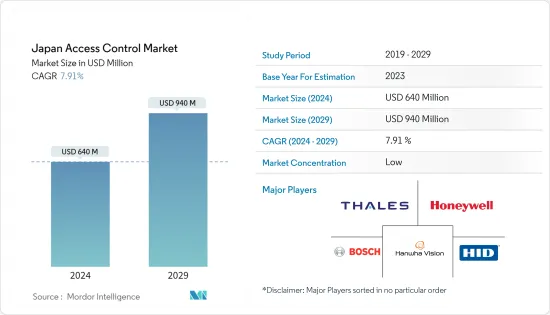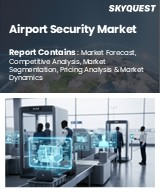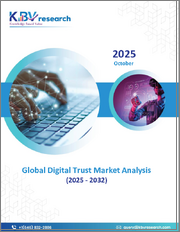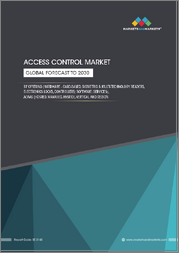
|
시장보고서
상품코드
1550531
일본의 액세스 컨트롤 : 시장 점유율 분석, 산업 동향·통계, 성장 예측(2024-2029년)Japan Access Control - Market Share Analysis, Industry Trends & Statistics, Growth Forecasts (2024 - 2029) |
||||||
일본의 액세스 컨트롤 시장 규모는 2024년에 6억 4,000만 달러로 추계되며, 2029년에는 9억 4,000만 달러에 달할 것으로 예측되며, 예측 기간 중(2024-2029년) CAGR은 7.91%로 성장할 것으로 예측됩니다.

기술의 발전과 보안에 대한 관심이 높아지면서 출입통제 시장은 일본에서 괄목할 만한 성장세를 보이고 있습니다. 생체인식, 얼굴 인식, AI를 활용한 출입 통제 시스템의 혁신으로 이러한 솔루션은 더욱 효과적이고 매력적으로 변모하고 있습니다. 일본의 강력한 기술 인프라는 이러한 첨단 시스템의 채택을 지원하고 있습니다.
주요 하이라이트
- 접근 제어는 출입 카드를 크리덴셜 리더(자격 증명 판독기)에 제시하여 허가된 인원이 제한된 공간, 통제된 공간 또는 안전한 공간에 출입할 수 있도록 하는 전자 시스템입니다. 이러한 시스템은 물리적 보안을 관리하기 위한 종합적이고 유연한 접근 방식을 제공합니다. 보안을 강화하고, 책임성을 높이며, 다양한 용도의 편의성을 제공합니다.
- 일본이 도시 인프라를 지속적으로 발전시키면서 상업용 건물, 공동주택, 공공장소에 대한 첨단 보안 시스템의 필요성이 증가하고 있습니다. 미국 중앙정보국(CIA)에 따르면 일본의 도시 인구는 전년 대비 92% 증가했습니다. 또한 일본 국토교통성에 따르면 건축물 건설에 대한 투자 금액은 2022년 43조 2,000억 엔에서 2023년 43조 4,000억 엔으로 증가할 것으로 예측됩니다.
- 인프라 구축에 대한 정부의 투자 증가는 시장 개척에 긍정적인 전망을 가져다주고 있습니다. 예를 들어 일본 정부는 2023년 12월, 2025년 오사카 간사이 엑스포 개최를 위한 행사장 접근성 등 인프라 구축에 8,390억 엔(58억 달러)을 투자할 것이라고 발표했습니다.
- 전국적인 데이터센터 개발이 시장 성장을 촉진할 것으로 예상됩니다. 데이터센터에는 중요하고 민감한 정보가 저장되어 있으며, 물리적 침해의 표적이 되기 쉽습니다. 2024년 2월, Yondr Group은 일본 대기업인 마루베니(Marubeni)와 일본내 데이터센터 개발을 위해 제휴를 맺었으며, 양사는 우선 서도쿄에 데이터센터를 설립할 예정입니다. 양사는 우선 서도쿄에 데이터센터를 건설하고 추가 프로젝트도 계획하고 있습니다.
- 그러나 고급 출입통제 시스템을 도입하려면 하드웨어, 소프트웨어, 설치 등 초기 비용이 많이 듭니다. 예산이 한정된 중소기업의 경우, 이러한 비용이 걸림돌이 될 수 있습니다. 또한 새로운 출입통제 시스템을 기존 인프라 및 다른 보안 시스템과 통합하는 것은 복잡하고 어려울 수 있습니다. 호환성 문제나 전문 기술 지식의 필요성이 도입의 걸림돌이 되기도 합니다.
- 인플레이션율 상승으로 인해 출입통제 시스템을 포함한 상품 및 서비스 비용이 상승하고 있습니다. 비용 상승은 소비자와 기업의 구매력 저하로 이어져 시장 성장을 둔화시킵니다. 또한 러시아와 우크라이나의 전쟁은 전 세계 공급망을 혼란에 빠뜨렸고, 특히 출입 통제 시스템에 사용되는 전자 부품 및 원자재의 가용성과 비용에 영향을 미쳤습니다. 이로 인해 생산 지연이 발생하여 제조업체의 비용 증가로 이어졌습니다.
일본의 출입통제 시장 동향
스마트카드 부문이 시장에서 괄목할 만한 성장세를 기록할 것으로 예상
- 스마트 카드는 보안 액세스 컨트롤 시스템의 표준이 되고 있습니다. 이 카드에는 카드 소지자의 개인 정보와 출입이 허용된 특정 출입 지점에 대한 정보가 프로그래밍된 컴퓨터 칩이 내장되어 있습니다. 이 카드는 근접 시스템, 마그네틱 스트라이프 시스템, 생체인식 시스템 등 다양한 기술과 통합되어 유연하고 효과적인 보안 솔루션을 구현할 수 있습니다.
- 스마트카드는 암호화 및 기밀 데이터의 안전한 저장과 같은 강력한 보안 기능을 갖추고 있으며, 안전한 인증이 필요한 용도에 적합합니다. 스마트카드의 높은 처리 능력과 메모리는 인증을 위해 고도로 암호화된 데이터를 크리덴셜 리더기에 전송할 수 있으며, 보안을 크게 강화합니다.
- 빌딩과 도시에 IoT 기기 및 스마트 인프라가 도입됨에 따라 통합된 보안 액세스 컨트롤 시스템의 필요성이 증가하고 있습니다. 스마트카드는 안전하고 편리한 액세스를 제공함으로써 이 생태계에서 중요한 역할을 하고 있습니다. 또한 클라우드 기반 액세스 컨트롤 시스템으로의 전환은 스마트카드의 채택에 영향을 미치고 있습니다. 클라우드 솔루션은 확장성, 유연성, 원격 관리 기능을 제공하여 스마트카드를 이러한 시스템에 필수적인 요소로 만들고 있습니다.
- 정부 구상은 사회 5.0 개념을 통해 시장 수요를 촉진하고 있습니다. 이 비전은 사회 1.0(수렵 채집), 사회 2.0(농업), 사회 3.0(산업화), 사회 4.0(정보화) 등 지금까지의 사회 단계를 기반으로 합니다. '초스마트 사회'로 알려진 소사이어티 5.0은 빅데이터 분석, AI, IoT, 로봇공학 등 디지털 기술을 활용해 지속가능하고 종합적인 사회경제 모델을 구축하는 것을 목표로 합니다.
- 특히 상업, 주거, 시설 분야에서는 보안에 대한 관심이 높아지면서 출입 통제에 스마트카드 시스템을 도입하는 사례가 늘고 있습니다. 스마트카드는 기존 키에 비해 더 높은 수준의 보안을 제공합니다. 암호화를 사용하고 특정 구역에 대한 접근을 허용하도록 프로그래밍할 수 있으며, 무단 침입의 위험을 줄일 수 있습니다. 일본 국토교통성의 발표에 따르면 2023년에는 일본에서 약 81만 9,600가구의 주택 착공이 예정되어 있습니다.
산업 부문이 큰 시장 점유율을 차지할 것으로 예상됩니다.
- 일본의 산업 부문은 역사적으로 일본 경제의 핵심이며 GDP와 세계 무역에 크게 기여해 왔습니다. 일본은 특히 로봇 공학, 자동차, 전자 분야의 기술 발전으로 유명합니다. 이러한 분야의 끊임없는 기술 혁신은 성장을 가속하고 일본을 세계 산업 발전의 최전선에 위치시켰습니다.
- 많은 산업 제조 시설의 주요 목표는 안전과 생산성입니다. 후자의 목표는 근로자, 방문객, 공장 관리자 및 기타 리더가 안전하고 안심할 수 있는 장소를 확보하는 데 크게 의존합니다. 따라서 산업 제조 현장의 물리적 보안 수준을 높여 위협을 감지하고, 침입을 방지하고, 예기치 못한 상황이 발생했을 때 적절하고 신속하게 대응할 수 있도록 해야 합니다.
- 출입 통제 시스템 및 관리 툴와 같은 통합 보안 솔루션은 보안 운영 및 보고를 간소화하고 강화하기 위해 산업 현장에서 크게 채택되고 있습니다. 액세스 컨트롤은 이러한 솔루션을 원활하게 통합하여 산업 제조 시설이 안전 및 생산성 목표를 달성할 수 있도록 지원하는 방법입니다. 대표적인 솔루션으로는 생체인식, 스마트 센서, 근접 카드 등이 있습니다.
- 공장 관리자는 모든 취약점을 줄이기 위해 직원과 방문객의 신원을 정확하게 확인할 수 있는 툴로 생체인식 기술을 도입하는 것을 고려해야 합니다. 생체인식의 다중 스펙트럼 이미지 기술은 최신 편광 비전과 피부 표면, 표면 아래 및 피하 구조에서 데이터를 수집하는 데 사용되는 다양한 유형의 빛을 통해 실제 손가락 끝과 가짜 손가락 끝을 감지하지 못할 위험을 줄입니다.
- 성장하는 산업 부문은 출입 통제 장비에 대한 수요를 창출할 것으로 예상됩니다. 일본 경제산업성에 따르면 일본의 전자산업 총생산액은 2023년 약 10조 7,000억 엔(760억 달러)에 달했습니다. 이 산업에는 소비자 전자기기, 산업용 전자기기, 전자 부품 및 장비가 포함됩니다.
일본의 출입통제 산업 개요
일본의 출입통제 시장은 국내외에 많은 주요 기업이 존재하므로 경쟁이 치열합니다. 시장은 세분화되어 있으며, 주요 기업은 제품 혁신과 M&A 등의 전략을 채택하고 있습니다. 이 시장의 주요 기업에는 Thales Group, Bosch Security System Inc., Idemia Group, HID Global, Axis Communications가 포함됩니다.
- 2024년 3월: 디지털 보안 및 ID 회사인 Identiv Inc.가 자사의 고보안 물리적 접근 제어 시스템(PACS) 포트폴리오에 획기적인 추가 제품인 ScrambleFactor를 발표했습니다. ScrambleFactor 리더는 지문 생체인식과 최첨단 LCD 터치스크린 키패드를 통해 연방 시장용 보안 출입을 재구축하고 여러 인증 방법을 통합하여 독보적인 보안, 속도, 기능 및 편의성을 제공합니다.
- 2024년 2월: 하이크비전은 2세대 전문가용 출입통제 제품을 발표했습니다. 이 신제품과 기능은 액세스 관리의 큰 도약을 의미하며, 웹 관리, 유연한 인증, 전문 액세스 용도, 통합 및 통합 보안 솔루션의 혁신을 포함합니다.
기타 혜택
- 엑셀 형식의 시장 예측(ME) 시트
- 3개월간의 애널리스트 지원
목차
제1장 서론
- 조사의 전제조건과 시장 정의
- 조사 범위
제2장 조사 방법
제3장 개요
제4장 시장 인사이트
- 시장 개요
- 업계의 매력 - Porter's Five Forces 분석
- 신규 진출업체의 위협
- 구매자/소비자의 교섭력
- 공급 기업의 교섭력
- 대체품의 위협
- 경쟁 기업 간 경쟁 관계
- 산업 밸류체인 분석
- COVID-19 부작용과 기타 거시경제 요인이 시장에 미치는 영향
제5장 시장 역학
- 시장 성장 촉진요인
- 범죄율과 위협의 증가에 의한 액세스 컨트롤 시스템의 채택 확대
- 기술의 진보
- 시장 성장 억제요인
- 운영과 ROI에 대한 우려
제6장 기술 스냅숏
- 액세스 컨트롤 솔루션의 진화
- RFID와 NFC 기술의 비교 분석
- 주요 기술 동향
제7장 시장 세분화
- 유형별
- 카드 리더 및 액세스 컨트롤 기기
- 카드식
- 근접형
- 스마트카드(접촉·비접촉)
- 바이오메트릭 리더
- 전자 잠금장치
- 소프트웨어
- 기타 유형
- 카드 리더 및 액세스 컨트롤 기기
- 업계별
- 상업
- 주택용
- 정부기관
- 산업용
- 운송·물류
- 헬스케어
- 군·방위
- 기타 최종사용자 업계별
제8장 경쟁 구도
- 기업 개요
- Hanwha Techwin Co. Ltd
- Thales Group(Gemalto NV)
- Bosch Security System Inc.
- HID Global Corporation
- Honeywell International Inc.
- Tyco International PLC(Johnson Controls)
- Allegion PLC
- ASSA ABLOY AB Group
- Schneider Electric SE
- Panasonic Corporation
- Brivo Systems, LLC
- Identiv Inc.
- Dormakaba Holding AG
- NEC Corporation
- Idemia Group
- Axis Communications AB
- Dahua Technology
- Genetec Inc.
- BioConnect Inc.
제9장 투자 분석
제10장 시장의 미래
KSA 24.10.07The Japan Access Control Market size is estimated at USD 640 million in 2024, and is expected to reach USD 940 million by 2029, growing at a CAGR of 7.91% during the forecast period (2024-2029).

The market for access control is witnessing significant growth in Japan owing to technological advancements and increased security concerns. Innovations in biometrics, facial recognition, and AI-driven access control systems make these solutions more effective and appealing. Japan's strong technological infrastructure supports the adoption of these advanced systems.
Key Highlights
- Access control is an electronic system that allows authorized personnel to enter restricted, controlled, or secure spaces by presenting an access card to a credential reader. These systems provide a comprehensive and flexible approach to managing physical security. They offer enhanced security, improved accountability, and convenience for various applications.
- As Japan continues to develop its urban infrastructure, there is a growing need for sophisticated security systems in commercial buildings, residential complexes, and public spaces. According to the Central Intelligence Agency, Japan's urban population was 92% the previous year. Further, as per the MLIT (Japan), investment in building construction was forecasted to increase to JPY 43.4 trillion in 2023 from JPY 43.2 trillion in 2022.
- The increasing government investments in infrastructural developments are creating a positive outlook for market growth. For instance, in December 2023, the central government announced that the overall costs to develop infrastructure, such as access to venues, for the 2025 Osaka Kansai Expo would be a total of JPY 839 billion (USD 5.8 billion).
- The development of data centers across the country is expected to boost market growth. Data centers house critical and sensitive information, making them prime targets for physical breaches. Advanced access control systems are essential to ensure that only authorized personnel can access these facilities. In February 2024, Yondr Group formed a partnership with Japanese conglomerate Marubeni Corporation for the development of data centers in Japan. The two will initially build a data center in West Tokyo, with plans for further projects.
- However, the upfront cost of implementing advanced access control systems, including hardware, software, and installation, can be significant. This can be a deterrent for small and medium-sized businesses with limited budgets. Additionally, integrating new access control systems with existing infrastructure and other security systems can be complex and challenging. Compatibility issues and the need for specialized technical expertise can hinder adoption.
- The rising inflation rates have increased the cost of goods and services, including access control systems. Higher costs lead to reduced purchasing power for consumers and businesses, slowing market growth. Further, the war between Russia and Ukraine disrupted the global supply chain, particularly affecting the availability and cost of electronic components and raw materials used in access control systems. This led to delays in production and increased costs for manufacturers.
Japan Access Control Market Trends
The Smart Card Segment is Expected to Register Significant Growth in the Market
- Smartcards are increasingly becoming the standard for secure access control systems. These cards contain an embedded computer chip programmed with personal information about the cardholder and the specific access points they are permitted to enter. These cards can be integrated with various technologies, such as proximity, magnetic-stripe, and biometric systems, to create a flexible and effective security solution.
- Smartcards offer robust security features such as encryption and secure storage of sensitive data, making them ideal for applications that require secure authentication. The advanced processing capabilities and memory of smart cards allow them to transmit highly encrypted data to credential readers for authentication, significantly enhancing security.
- The increasing adoption of IoT devices and smart infrastructure in buildings and cities drives the need for integrated and secure access control systems. Smart cards play a key role in this ecosystem by providing secure and convenient access. Further, the shift toward cloud-based access control systems influences the adoption of smart cards. Cloud solutions offer greater scalability, flexibility, and remote management capabilities, making smart cards an integral part of these systems.
- Government initiatives are driving market demand through the concept of Society 5.0. This vision builds on previous societal phases: Society 1.0 (hunter-gatherer), Society 2.0 (agricultural), Society 3.0 (industrialized), and Society 4.0 (information). Known as the 'super-smart society,' Society 5.0 aims to create a sustainable, inclusive socio-economic model by leveraging digital technologies such as big data analytics, AI, IoT, and robotics.
- New constructions, particularly in commercial, residential, and institutional sectors, are increasingly incorporating smart card systems for access control due to increased security concerns. Smart cards provide a higher level of security compared to traditional keys. They use encryption and can be programmed to allow access to specific areas, reducing the risk of unauthorized entry. As per the MLIT (Japan), in 2023, approximately 819.6 thousand housing starts were initiated in Japan.
The Industrial Sector is Anticipated to Hold a Significant Market Share
- Japan's industrial sector has historically been a cornerstone of its economy, contributing significantly to its GDP and global trade presence. The country is renowned for its technological advancements, particularly in robotics, automotive, and electronics. Continuous innovation in these fields drives growth and keeps Japan at the forefront of global industrial development.
- The primary objectives of many industrial manufacturing facilities are safety and productivity. The latter goal significantly depends on ensuring a safe and secure place for workers, visitors, plant managers, and other leaders. As such, there is a need to increase the level of physical security in industrial manufacturing settings to detect threats, prevent intrusion, and respond appropriately and quickly in the case of any unwanted event.
- Integrated security solutions, such as access control systems and management tools, are significantly adopted in industrial sites to streamline and enhance security operations and reporting. Access control is a way to seamlessly fuse these solutions and help the industrial manufacturing facility reach its goals of safety and productivity. Some of the prime solutions include biometrics, smart sensors, and proximity cards.
- Plant managers should consider adopting biometrics as a tool to accurately verify the staff and visitor identity to reduce any vulnerability. Biometrics' multispectral imaging technology reduces the risk of not detecting the real fingertip from a fake one due to modern polarization vision and different types of light used in capturing the data from the surface, subsurface, and subdermal structures of the skin.
- The growing industrial sector is expected to generate demand for access control devices. According to METI (Japan), the total production value of Japan's electronics industry reached approximately JPY 10.7 trillion (USD 0.076 trillion) in 2023. This industry includes consumer electronic equipment, industrial electronic equipment, and electronic components and devices.
Japan Access Control Industry Overview
The Japanese access control market is highly competitive due to the presence of many key players within national and international boundaries. The market appears fragmented, with the key players adopting strategies like product innovation and mergers and acquisitions. Major players in the market include Thales Group, Bosch Security System Inc., Idemia Group, HID Global, and Axis Communications.
- March 2024: Identiv Inc., a digital security and identification company, introduced ScrambleFactor, a groundbreaking addition to its high-security physical access control system (PACS) portfolio. The ScrambleFactor reader reimagines secure entry for the federal market with fingerprint biometrics and a state-of-the-art LCD touchscreen keypad, integrating multiple authentication methods to deliver unparalleled security, speed, functionality, and convenience.
- Feb 2024: Hikvision launched its second-generation professional access control products. The new products and functionalities represent a significant leap forward in access management and include innovations for web management, flexible authentication, professional access applications, and converged and unified security solutions.
Additional Benefits:
- The market estimate (ME) sheet in Excel format
- 3 months of analyst support
TABLE OF CONTENTS
1 INTRODUCTION
- 1.1 Study Assumptions and Market Definition
- 1.2 Scope of the Study
2 RESEARCH METHODOLOGY
3 EXECUTIVE SUMMARY
4 MARKET INSIGHTS
- 4.1 Market Overview
- 4.2 Industry Attractiveness - Porter's Five Forces Analysis
- 4.2.1 Threat of New Entrants
- 4.2.2 Bargaining Power of Buyers/Consumers
- 4.2.3 Bargaining Power of Suppliers
- 4.2.4 Threat of Substitute Products
- 4.2.5 Intensity of Competitive Rivalry
- 4.3 Industry Value Chain Analysis
- 4.4 Impact of COVID-19 Aftereffects and Other Macroeconomic Factors on the Market
5 MARKET DYNAMICS
- 5.1 Market Drivers
- 5.1.1 Growing Adoption of Access Control Systems owing to Rising Crime Rates and Threats
- 5.1.2 Technological Advancements
- 5.2 Market Restraints
- 5.2.1 Operational and ROI Concerns
6 TECHNOLOGY SNAPSHOT
- 6.1 Evolution of Access Control Solutions
- 6.2 Comparative Analysis of RFID and NFC Technology
- 6.3 Key Technological Trends
7 MARKET SEGMENTATION
- 7.1 By Type
- 7.1.1 Card Reader and Access Control Devices
- 7.1.1.1 Card-based
- 7.1.1.2 Proximity
- 7.1.1.3 Smartcard (Contact and Contactless)
- 7.1.2 Biometric Readers
- 7.1.3 Electronic Locks
- 7.1.4 Software
- 7.1.5 Other Types
- 7.1.1 Card Reader and Access Control Devices
- 7.2 By End-user Vertical
- 7.2.1 Commercial
- 7.2.2 Residential
- 7.2.3 Government
- 7.2.4 Industrial
- 7.2.5 Transport and Logistics
- 7.2.6 Healthcare
- 7.2.7 Military and Defense
- 7.2.8 Other End-user Verticals
8 COMPETITIVE LANDSCAPE
- 8.1 Company Profiles
- 8.1.1 Hanwha Techwin Co. Ltd
- 8.1.2 Thales Group (Gemalto NV)
- 8.1.3 Bosch Security System Inc.
- 8.1.4 HID Global Corporation
- 8.1.5 Honeywell International Inc.
- 8.1.6 Tyco International PLC (Johnson Controls)
- 8.1.7 Allegion PLC
- 8.1.8 ASSA ABLOY AB Group
- 8.1.9 Schneider Electric SE
- 8.1.10 Panasonic Corporation
- 8.1.11 Brivo Systems, LLC
- 8.1.12 Identiv Inc.
- 8.1.13 Dormakaba Holding AG
- 8.1.14 NEC Corporation
- 8.1.15 Idemia Group
- 8.1.16 Axis Communications AB
- 8.1.17 Dahua Technology
- 8.1.18 Genetec Inc.
- 8.1.19 BioConnect Inc.

















